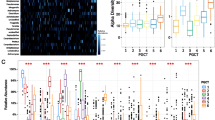Abstract
Background
Necrotizing enterocolitis (NEC) leads to significant morbidity and mortality in the neonatal intensive care unit. Although current evidence would suggest that bacteria contribute to the pathogenesis of NEC, no single bacterium has yet been identified.
Aims
The aims of this study were to investigate fecal S100A12 concentrations and the intestinal bacterial community in premature infants (24–32 weeks) and investigate any associations between the microbiota and the development of NEC.
Methods
Meconium and feces were collected from premature newborn infants (between 24 and 32 weeks gestation) over the first 4 weeks of life. Fecal S100A12 concentrations were assayed by immunoassay, and samples were subject to 16S rDNA analysis using next-generation sequencing techniques.
Results
Fecal samples were collected from four infants that developed NEC and 18 control infants. Prior to developing NEC, fecal S100A12 concentrations were not elevated; however, following NEC diagnosis, concentrations were highly elevated. The fecal bacterial communities of infants with NEC did not differ significantly from control infants. However, potentially pathogenic bacteria were detected in significantly more infants with NEC than in controls (p = 0.0007).
Conclusion
At birth, fecal S100A12 concentrations were not elevated in premature infants subsequently developing NEC in this cohort. Following NEC diagnosis, S100A12 concentrations were highly elevated, suggesting that this potentially could act as a marker of disease progression. Higher detection rates of potentially pathogenic bacteria in NEC infants suggest that a range of potentially pathogenic bacteria may collectively contribute to NEC pathogenesis.



Similar content being viewed by others
References
Gephart SM, McGrath JM, Effken JA, Halpern MD. Necrotizing enterocolitis risk: state of the science. Adv Neonatal Care. 2012;12:77–87.
Morgan JA, Young L, McGuire W. Pathogenesis and prevention of necrotizing enterocolitis. Curr Opin Infect Dis. 2011;24:183–189.
Alfaleh K, Anabrees J, Bassler D, Al-Kharfi T. Probiotics for prevention of necrotizing enterocolitis in preterm infants Cochrane Database Syst Rev. 2011;CD005496.
Wang Y, Hoenig JD, Malin KJ, et al. 16S rRNA gene-based analysis of fecal microbiota from preterm infants with and without necrotizing enterocolitis. ISME J. 2009;3:944–954.
Guignard F, Mauel J, Markert M. Identification and characterization of a novel human neutrophil protein related to the S100 family. Biochem J. 1995;309:395–401.
Foell D, Kucharzik T, Kraft M, et al. Neutrophil derived human S100A12 (EN-RAGE) is strongly expressed during chronic active inflammatory bowel disease. Gut. 2003;52:847–853.
de Jong NS, Leach ST, Day AS. Fecal S100A12: a novel noninvasive marker in children with Crohn’s disease. Inflamm Bowel Dis. 2006;12:566–572.
Andreotti R, Perez de Leon AA, Dowd SE, Guerrero FD, Bendele KG, Scoles GA. Assessment of bacterial diversity in the cattle tick Rhipicephalus (Boophilus) microplus through tag-encoded pyrosequencing. BMC Microbiol. 2011;11:6.
Bailey MT, Dowd SE, Parry NM, Galley JD, Schauer DB, Lyte M. Stressor exposure disrupts commensal microbial populations in the intestines and leads to increased colonization by Citrobacter rodentium. Infect Immun. 2010;78:1509–1519.
Finegold SM, Dowd SE, Gontcharova V, et al. Pyrosequencing study of fecal microflora of autistic and control children. Anaerobe. 2010;16:444–453.
Handl S, Dowd SE, Garcia-Mazcorro JF, Steiner JM, Suchodolski JS. Massive parallel 16S rRNA gene pyrosequencing reveals highly diverse fecal bacterial and fungal communities in healthy dogs and cats. FEMS Microbiol Ecol. 2011;76:301–310.
DeSantis TZ, Hugenholtz P, Larsen N, et al. Greengenes, a chimera-checked 16S rRNA gene database and workbench compatible with ARB. Appl Environ Microbiol. 2006;72:5069–5072.
Bell MJ, Ternberg JL, Feigin RD, et al. Neonatal necrotizing enterocolitis. Therapeutic decisions based upon clinical staging. Ann Surg. 1978;187:1–7.
Day AS, Ehn M, Gearry RB, Lemberg DA, Leach ST. Fecal S100A12 in healthy infants and children. Dis Markers. 2013;35:295–299.
Dabritz J, Jenke A, Wirth S, Foell D. Fecal phagocyte-specific S100A12 for diagnosing necrotizing enterocolitis. J Pediatr. 2012;161:1059–1064.
Mai V, Young CM, Ukhanova M, et al. Fecal microbiota in premature infants prior to necrotizing enterocolitis. PLoS ONE. 2011;6:e20647.
Superti SV SV, de Martins DS, Caierao J, et al. Corynebacterium striatum infecting a malignant cutaneous lesion: the emergence of an opportunistic pathogen. Rev Inst Med Trop Sao Paulo. 2009;51:115–116.
Salen PN, Eppes S. Morganella morganii: a newly reported, rare cause of neonatal sepsis. Acad Emerg Med.. 1997;4:711–714.
Krasna IH, Kurgan A, Noy S. Pseudomonas septicemia; necrotizing bowel lesions (NEC) and skin lesions in a 5-mo-old child. J Pediatr Surg. 1979;14:481–482.
Oteo J, Aracil B, Ignacio Alos J, Luis Gomez-Garces J. Significant bacteremias by Corynebacterium amycolatum: an emergent pathogen. Enferm Infecc Microbiol Clin. 2001;19:103–106.
Fernandes N, Steinberg P, Rusch D, Kjelleberg S, Thomas T. Community structure and functional gene profile of bacteria on healthy and diseased thalli of the red seaweed Delisea pulchra. PLoS ONE. 2012;7:e50854.
Acknowledgments
We thank Ananthaen Killikulangara, Ben Rayner, Catherine Smith, and Fathalla Ali for assisting with sample and data collection and processing. Laboratory work was undertaken in the Westfield Research Laboratories in Sydney Children’s Hospital.
Author information
Authors and Affiliations
Corresponding author
Ethics declarations
Conflicts of Interest and Source of Funding
Funding for this project was provided by the Sydney Children’s Hospital Foundation, the Leslie Stevens Fund for Newborn Care, and the Madison Capaldi Research Fund, Royal Hospital for Women Foundation. The authors have no conflicts of interest.
Rights and permissions
About this article
Cite this article
Leach, S.T., Lui, K., Naing, Z. et al. Multiple Opportunistic Pathogens, but Not Pre-existing Inflammation, May Be Associated with Necrotizing Enterocolitis. Dig Dis Sci 60, 3728–3734 (2015). https://doi.org/10.1007/s10620-015-3830-6
Received:
Accepted:
Published:
Issue Date:
DOI: https://doi.org/10.1007/s10620-015-3830-6




